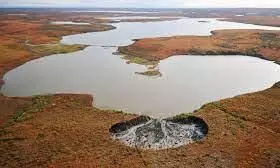
Arctic permafrost thaw threatens spread of toxic industrial pollutants
text_fieldsThe Arctic is warming up due to global warming and climate change. This comes up with several dangers including rising sea levels and natural calamities. However, scientists have raised a new concern - the spread of toxic substances that are the result of industrial pollution.
These toxic substances will harm fish and other animals living in the Arctic waterways. This will in turn affect humans dependent on them.
The Arctic is warming at a pace four times faster than the rest of the planet. Some climate scientists also worry that the permafrost thaw in the Arctic can release antibiotic-resistant bacteria and viruses into the environment. Radioactive waste from nuclear testing programmes is also at risk of being released into the atmosphere.
According to a report in Nature Communications, over 2,000 industrial sites like mines, oil fields, military installations, and pipelines will be destabilised by the end of the century if the thaw continues at the same rate. This will also compromise over 5,000 areas that are already contaminated.
Diesel, gasoline, and related petrochemicals are about 50% of the pollutants scientists are worried about. Toxic substances like lead, arsenic, and mercury are also on the list because they can make fish, animals, humans, and other organisms sick.
Permafrost researchers are trying to pinpoint where the thaw could release industrial pollutants. Moritz Langer of the Alfred Wegener Institute said people are now seeing only the tip of the iceberg and there may already be even more unknown contaminated areas. Experts think 65% of the region's permafrost is going to disappear by 2100.
The team focused on the contamination data from Canada and Alaska for the study.





